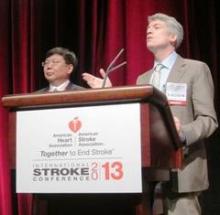A short course of clopidogrel plus aspirin safely reduced the risk of early recurrent stroke in Chinese patients with high-risk transient ischemic attack or minor stroke who participated in a randomized, double-blind, placebo-controlled trial.
The relative risk of any stroke within the first 90 days was 32% lower with aspirin and clopidogrel (Plavix) than with aspirin alone (hazard ratio, 0.68; P less than .001). The absolute reduction in ischemic stroke was 3.5% (7.9% vs. 11.4%; P less than .0001).
There was no signal to suggest that dual antiplatelet therapy was unsafe, Dr. Yongjun Wang reported during a late-breaking plenary session at the International Stroke Conference.
The risk of any bleeding was 2.3% with clopidogrel plus aspirin and 1.6% with aspirin alone (P = .09). The risk of severe bleeding was 0.2% in both groups.
Rates of hemorrhagic stroke, myocardial infarction, and cardiovascular death were the same.
Notably, most of the benefit with dual antiplatelet therapy occurred early on in the trial, called CHANCE (Clopidogrel in High-Risk Patients With Acute Non-disabling Cerebrovascular Events) before day 21, underscoring the importance of treating acutely.
"Even more aggressive interventions after acute TIA and minor stroke may be indicated but require more clinical trials," said Dr. Wang of Beijing (China) Tiantan Hospital.
A coinvestigator on the multicenter trial, Dr. S. Claiborne Johnston, director of the stroke service at the University of California, San Francisco, said the risk reduction was large in CHANCE but also observed that there are important differences in health care between China and the United States or Europe, such as undertreatment of conditions such as hypertension during poststroke follow-up. There also are differences in stroke subtyping and a higher frequency of polymorphisms that reduce clopidogrel efficacy.
He suggested that the positive results will likely spur enrollment in the North American, phase III POINT (Platelet-Oriented Inhibition in New TIA and Minor Ischemic Stroke) trial, of which he is also a coinvestigator.
POINT uses a 600-mg loading dose of clopidogrel within 12 hours of symptom onset, followed by 75 mg of clopidogrel daily plus aspirin 50-325 mg/day for 90 days. In contrast, CHANCE randomized 5,170 patients within 24 hours of symptom onset. One group received a 300-mg loading dose of clopidogrel, followed by 75 mg daily during days 2-90 plus 75-300 mg of aspirin open-label on the first day followed by 75 mg/day blinded during days 2-21 and a placebo for aspirin during days 22-90. A second group received aspirin 75-300 mg open-label on the first day, followed by 75 mg/day during days 2-90 and a placebo for clopidogrel during days 1-90.
For years, physicians have been advised not to use clopidogrel plus aspirin in stroke patients unless there’s a compelling reason because it can increase their already elevated risk of major and life-threatening bleeding. Those recommendations, however, were based on long-term use of dual antiplatelet therapy in all comers with stroke, commented Dr. Philip Gorelick, medical director of the Hauenstein Neuroscience Center in Grand Rapids, Mich., who has helped pen some of the recurrent stroke prevention guidelines.
"We’ve been beating that drum for years now and we finally got doctors to stop," he said in an interview. "But what we’re seeing here is that, in the acute period, it not only appears to be safe to have the dual combination of aspirin plus clopidogrel but it also reduces the risk of early stroke in those TIA and minor stroke patients. ...
"It’s a focused indication with good patient selection that’s made the difference here."
Dr. Gorelick predicted that guidelines will change within the next 12-18 months to reflect the current findings supporting early, short-term use of clopidogrel plus aspirin in this subgroup of patients. He suggested that the standard for now will be 21 days of aspirin plus clopidogrel, unless data emerge from POINT to suggest otherwise.
In CHANCE, 2,586 patients were treated with aspirin alone and 2,584 with clopidogrel plus aspirin. Roughly two-thirds had a nondisabling ischemic stroke (National Institutes of Health Stroke Scale score of 3 or less) and one-third had a TIA with moderate-to-high risk of stroke recurrence (ABCD2 score of 4 or more). Their average age was 62 years and 63 years, respectively. The average time to randomization was 13 hours in both groups.
The secondary combined outcome of stroke, myocardial infarction, or death from cardiovascular causes was significantly reduced with clopidogrel plus aspirin (HR, 0.69; P less than .001), Dr. Wang reported at the meeting, which was sponsored by the American Heart Association.


